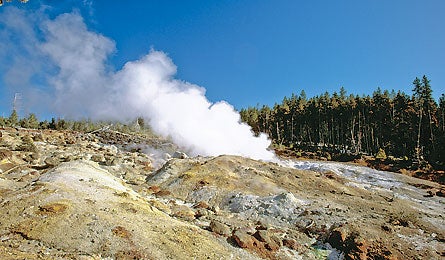Wilderness Wonders: Hottest Geysers

'You better step back when these geysers start erupting. (Photo- Jerry Pavia)'
Biggest Cave | Scariest Predator | Driest Desert | Hottest Geysers | Largest Glacier | Highest Peak | Tallest Tree | Highest Biodiversity | Largest Primate | Most Active Volcano | Strangest Rock Formation | Biggest Bear | Largest Crater | Farthest Migrator | Tallest Waterfall
What In most places, rain and snow soak into the ground with little fanfare. But in thermal hot zones, where magma lies close to the surface, precipitation seeps down to superheated rocks–then convection and pressure push it back up through porous and fractured stone in a steamy eruption. The water cools and returns to the ground, and the cycle begins again.
Where Yellowstone National Park, Wyoming. The hottest gushers of this geothermal mecca (half of the world’s geysers are found here) lie in Norris Geyser Basin, where underground temperatures have topped 450°F. Check out the basin’s red-orange landscape (due to iron oxides and arsenic in the water) and more than 70 boiling geysers–including Steamboat Geyser, the planet’s highest at 400 feet. Then leave the crowds behind on a 10.6-mile hike to Cascade Lake; pick up the Howard Eaton Trail just off of Norris Junction. nps.gov/yell